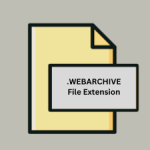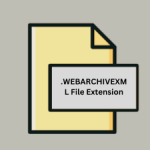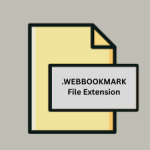.KIT File Extension
What is an KIT file?
.KIT files, colloquially known as CodeKit files, encapsulate various resources essential for web development projects.
These resources typically include HTML, CSS, JavaScript, and image files, among others. CodeKit, a versatile front-end development tool tailored for macOS, harnesses the potential of .KIT files to automate tasks such as compilation, minification, and browser synchronization.
By consolidating these resources into a single entity, .KIT files facilitate seamless project management and optimization.
More Information.
Upon its release, CodeKit garnered widespread acclaim within the web development community for its intuitive interface and comprehensive feature set. .KIT files epitomized the core philosophy of CodeKit, which prioritized efficiency and ease of use.
Initially conceived as a macOS-exclusive tool, CodeKit and its associated .KIT files soon gained traction among developers seeking to streamline their workflows. With each iteration, CodeKit evolved to encompass new technologies and methodologies, thereby enhancing the functionality of .KIT files.
Origin Of This File.
The genesis of .KIT files can be traced back to the inception of CodeKit, developed by Bryan Jones in 2011. Frustrated by the repetitive nature of front-end development tasks, Jones embarked on a mission to simplify the process.
The result was CodeKit, a robust toolkit that revolutionized the way developers approach web design. .KIT files emerged as an integral component of CodeKit, serving as the container for project assets and configurations.
File Structure Technical Specification.
.KIT file is a structured archive that consolidates project resources and configuration settings. The precise composition of a .KIT file may vary depending on the specific requirements of the project.
Common elements include HTML, CSS, JavaScript, image files, and configuration files such as .config and .plist. These components are organized hierarchically within the .KIT file, enabling CodeKit to access and manipulate them seamlessly.
Underneath the hood, .KIT files adhere to established file compression standards such as ZIP or TAR. This ensures compatibility across different platforms and facilitates interoperability with third-party tools.
Despite their compressed nature, .KIT files preserve the integrity of enclosed resources, thereby mitigating the risk of data loss or corruption.
How to Convert the File?
Converting .KIT files to alternative formats entails extracting the enclosed resources and restructuring them according to the desired specifications.
Various third-party tools and utilities facilitate this process, offering conversion options tailored to specific use cases.
For instance, developers seeking to migrate from CodeKit to alternative build systems may utilize scripts or plugins designed for seamless transition.
Alternatively, developers can manually extract the contents of a .KIT file using archive management software such as WinZip or 7-Zip. This approach grants finer control over the conversion process, enabling customization of file paths and directory structures.
Manual conversion may prove time-consuming, especially for projects with extensive resource dependencies.
Advantages And Disadvantages.
Advantages:
- Resource Organization: .KIT files offer a centralized way to organize and manage various resources, facilitating easier access and maintenance.
- Portability: They can be easily shared or distributed, as they encapsulate all the necessary components within a single file.
- Customization: Developers can tailor the contents of .KIT files to suit specific requirements, enhancing flexibility and efficiency in application development.
Disadvantages:
- Complexity: Understanding and manipulating .KIT files may require familiarity with their underlying structure and the software ecosystem they belong to.
- Dependency Management: Changes to the contents of .KIT files may necessitate careful consideration of dependencies, ensuring compatibility and consistency across systems.
- Limited Interoperability: Due to their proprietary nature or software-specific implementations, .KIT files may face challenges when interoperating with other platforms or applications.
How to Open KIT?
Open In Windows
- CodeKit Emulation: Utilize virtualization software such as Parallels Desktop or VMware Fusion to emulate macOS on your Windows machine. Install CodeKit within the virtual environment to access and manage .KIT files seamlessly.
- Cross-platform Alternatives: Explore alternative build systems and task runners compatible with Windows, such as Prepros or Gulp. While these tools may not support .KIT files natively, they offer similar functionality for compiling, minifying, and managing web assets.
Open In Linux
- CodeKit Emulation: Similar to Windows, leverage virtualization software like VirtualBox or VMware Workstation to emulate macOS on your Linux system. Install CodeKit within the virtual environment to work with .KIT files effectively.
- Cross-platform Alternatives: Look for Linux-compatible alternatives to CodeKit, such as Prepros or Gulp. While these tools may not offer native support for .KIT files, provide comparable features for optimizing web development workflows.
Open In MAC
- Native Support: CodeKit is natively designed for macOS, making it the most straightforward option for opening .KIT files. Simply double-click on the .KIT file and it will automatically open in CodeKit, allowing you to access and manage project resources effortlessly.
Open In Android
- Cloud Storage: Upload the .KIT files to a cloud storage service such as Google Drive or Dropbox from a macOS or Windows device. Access the file using the corresponding mobile app on your Android device and transfer it to compatible applications for further processing.
- Third-party Apps: Look for file management apps on the Google Play Store that support ZIP file extraction. While .KIT files are not standard ZIP archives, some apps may offer partial compatibility for extracting embedded resources.
Open In IOS
- Cloud Storage: Upload the .KIT files to a cloud storage service like iCloud Drive or Dropbox from a macOS or Windows device. Access the file using the corresponding iOS app and transfer it to compatible applications for further handling.
- Third-party Apps: Explore file management apps available on the App Store that offer support for ZIP file extraction. While .KIT files are not conventional ZIP archives, some apps may provide limited functionality for accessing embedded resources.














